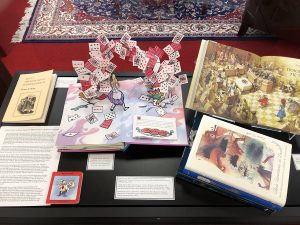Alice in Court: An Exhibit Taken from Editions of Alice’s Adventures in Wonderland
- January 24th, 2018
- by specialcollections
- in Book Notes, Exhibits
Take the opportunity to visit our exhibit “Alice in Court” located in the main hall of UA’s Law Library before it is replaced. The following post, “Alice in Court,” seeks to describe the legal aspects of one of the world’s great fantasy stories–Alice’s Adventures in Wonderland by Lewis Carroll. The exhibit includes works in a Lewis Carroll collection assembled by Litera Scripta co-editor Paul M. Pruitt, Jr.
Summary and Commentary:
On the afternoon of July 4, 1862, Charles Dodgson of Christ Church and Robinson Duckworth of Trinity, young Oxford dons, rowed three miles up the river Isis. They were accompanied by three young daughters of Christ Church dean Dr. H.G. Liddell and by Miss Prickett, the girls’ governess. By most accounts it was a golden afternoon.
Certainly it was golden for Dodgson—for in the course of rowing and picnicking he spun a long story in which the ten-year-old Alice (his particular favorite) followed a White Rabbit down a rabbit hole into the realm of Wonderland.

At her request he wrote and rewrote the tale, publishing it in 1865 under the pseudonym Lewis Carroll as Alice’s Adventures in Wonderland. It has since appeared in many editions, not to mention some three dozen films or tv shows.[1]
Carroll’s purpose, to be sure, is to entertain, yet his Alice must deal with a series of animal and human characters who are self-willed, indifferent to her well-being, even dangerous—just like certain types of people who inhabit what we are pleased to call the real world. At the same time Alice’s new acquaintances may be poignantly bizarre, relentlessly and wrong-headedly logical, and (more often than not) determined to recite poetry or hear it recited. Beyond the inspired nonsense that Alice hears and speaks, there are grown-up dimensions to several of these encounters. Many of Carroll’s episodes summon up topical issues (of law, psychology, and social class, among others) that are very much alive today.
It was Carroll’s genius to place the challenging scenes of Wonderland in a dreamlike setting and to seed his story with rollicking puns, jokes, and verses. All of these elements are heightened by Alice’s childlike candor and inquisitiveness. The story is told from her perspective, which allowed Carroll to make excellent use of the “real” Alice Liddell’s independent-minded personality. Surely, Carroll was a pioneer in following a child’s path through a satirically informed world. Mark Twain (another pseudonymous writer) would not perfect his master creation, Huckleberry Finn, for another twenty years.
Carroll was acutely aware that children, more than the rest of us, experience abrupt physical transformations. In the course of the narrative, Alice must cope with sudden changes in her own size, beginning with her first explorations at the bottom of the rabbit hole. There she experiences sudden shrinkage after drinking from a bottle labeled “DRINK ME” and rapid growth after eating a cake marked “EAT ME.” After shedding copious tears, she shrinks again (the result of holding the White Rabbit’s fan) and finds that she is swimming in a pool of her own tears. There Alice meets number of animals, including a Dodo—widely assumed to be a self-caricature of Dodgson. They all dry off by means of a “Caucus Race” (a jab at Parliamentary politics), at the conclusion of which the Dodo announces: “Everybody has won, and all must have prizes.”[2]
